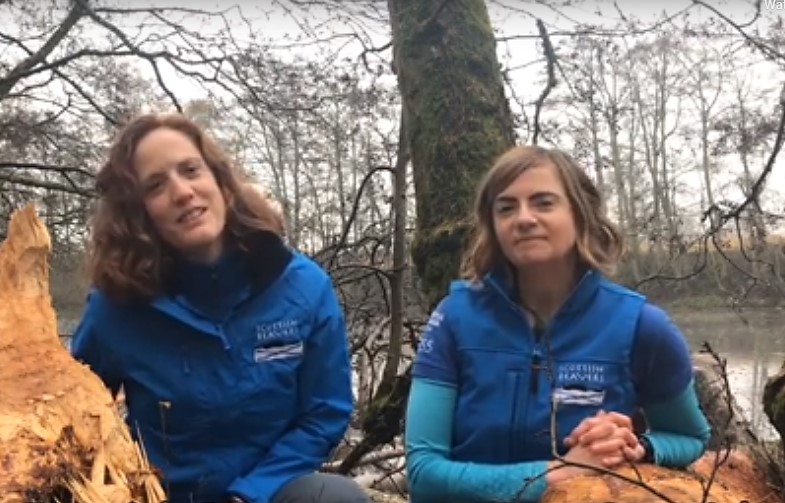International Day of Women and Girls in Science 2020 - Dr Helen Taylor and Gill Dowse
11/02/2020 in Conservation
A 2019 survey showed that for the first time ever, there are more than one million women working in core STEM (science, technology, engineering and mathematics) roles across the UK, sectors that have historically been male dominated.
The scientific community is leading that charge, with nearly 46% of the workforce consisting of women. This is a significantly higher proportion than that of the other STEM industries. To celebrate International Day of Women and Girls in Science 2020, we conducted interviews with four key female conservation partnerships working with and within RZSS and asked them to discuss their perspectives and opinions on their experience in the industry.
We'll be sharing the four interviews throughout the rest of the week (1, 2, 3, 4).
Dr Helen Taylor and Gill Dowse
Helen, conservation programme manager at RZSS, and Gill, knowledge and evidence manager at Scottish Wildlife Trust, are currently leading teams on the Scottish Beaver Project, which has successfully reintroduced beavers to Scotland.

Q) What was your biggest motivator to pursue a scientific career?
GD: I’ve always had an enquiring mind, loved problem solving and been passionate about the environment and conservation. My Dad wrote computer software and I inherited that analytical and logical approach from him – we always had computers in the house, which was very unusual back then, and I was absolutely fascinated about how they worked and what possibilities they could unlock.
HT: I’m the same in that my upbringing was pretty important in leading to my current career path – I had parents who made sure my brother and I got outdoors a lot, and my dad was always at pains to point out various plants and wildlife. We also watched a lot of David Attenborough in my house, which gave me a window on the natural world beyond the UK.
GD: I went on to study for a geography degree, and during this I spent some time mapping glacial moraines in Iceland, where I discovered the joys of GIS [Geographic Information System] and analysing data. I am an avid knitter, and a friend once observed that knitting charts are like colourful spreadsheets and that’s why I liked knitting so much – I have to admit they were right! I wanted to be able to use my logical approach to support conservation in some way – using evidence to help direct decision making about the natural environment was the perfect match.
HT: I had a bit of a weird career path where I did study zoology at university, but it didn’t quite click for me, so after graduating I went off and worked in public relations for six years. When I realised I was unhappy in that career, the early seeds of my interest in natural history were still there, and so I went and got some field work experience by volunteering in the Peruvian Amazon for four months. I was hooked! After that, everything I did was geared to pursuing a career in conservation science and finding ways to apply science to saving threatened species.
Q) What are your views on how opportunities for women in science have changed?
GD: When I started out at the Scottish Wildlife Trust, I was very often the only woman in a room full of data and GIS specialists, and often the youngest person too. The diversity has slowly shifted over the years and now it’s a regular occurrence for me to attend meetings entirely of women, or being run by women, which might be particular to the conservation sector.
HT: Having worked in academia for eight years before joining RZSS, I have to say that, in my experience, unfortunately a male bias persists – particularly at the senior level. There’s definitely a leaky pipeline when it comes to women in science, and while things are improving, that pipeline has not yet been plugged. Fortunately, there is lots of work going into improving diversity and inclusion in science, but I think we still have a way to go. Better is not the same as good enough.
GD: My kids think it’s completely normal that anyone can follow what interests or drives them, and there are no gender specific jobs anymore – I love that. There are still barriers to overcome, still daft comments made by older males about the women in a room, or references made to their attire rather than their input to the discussion, but we are making huge strides forward. More top roles are being taken by women and many of them are supporting the women coming up behind them – things aren’t going to change overnight, but we’re definitely moving in the right direction.
Hopefully this blog shows how, totally independent of gender, collaboration and commitment are the core elements of success.
The tenacity of inspirational individuals such as Mae Jemison (the first African American woman astronaut in space) is impactful regardless of gender, education, economic background or ethnicity. As Mae Jemison said “Don't let anyone rob you of your imagination, your creativity, or your curiosity. It's your place in the world; it's your life. Go on and do all you can with it and make it the life you want to live."
Featured Articles

An update from the Budongo Forest
19/04/2024 in Conservation

Edinburgh Zoo named best zoo in Scotland
15/04/2024 in Edinburgh Zoo

























Follow EZ